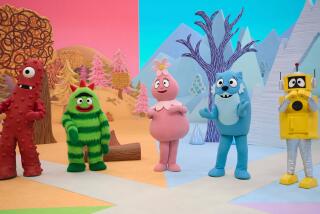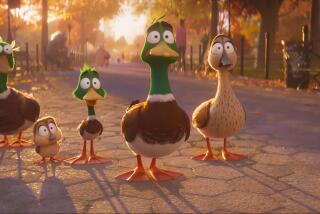MOVIE REVIEW : ‘Little Mermaid’ Makes Big Splash
Midway through The Disney Studio’s “The Little Mermaid,” (citywide), there’s a calypso number called “Under the Sea,” led by a hyper-sensitive crab named Sebastian, with his “hot crustacean band.” It’s a no-place-like-home number, with Sebastian trying to persuade the title character, tawny-tressed Ariel, not to think that “the seaweed’s greener . . . undah somebody else’s lake,” not to leave her ocean home in seemingly foredoomed pursuit of the handsome, human prince she has saved from shipwreck.
Ariel won’t listen. She’s a sturdy, headstrong girl, nubile prey for the evil sea-witch Ursula, who wants to steal her voice and soul. But, especially after this infectious showstopper by “Little Shop of Horror” songwriters Howard Ashman and Alan Menken, the audience will probably open right up. “The Little Mermaid”--impudent, grandiose, a multilevel crowd-pleaser--almost returns the Disney animated features to their glory traditions of the ‘30s and ‘40s.
It’s a different kind of film than the old classics. Coming after four decades of limited animation and MTV, it looks more hyper-active than “Snow White” or “Pinocchio.” There’s a heightened element of sexual sophistication in the story--partial nudity and double entendres, despite a “G” rating--and it shows off new wrinkles like computer animation, used for three-dimensional movement on the ships and shipwrecks.
But this movie, directed and written by John Musker and Ron Clements, with a yeoman team of animators, designers and crafts-people, shares with the classics a sense of over-reaching, of grabbing every snazzy effect possible within old-line narrative forms. Perhaps the literary source inspired everybody: director Jean Renoir, who adapted two Hans Christian Andersen tales himself, was among many who considered him a great writer.
It may be the setting. “The Little Mermaid,” with its largely sub-aqueous backgrounds, doesn’t have that flat, dry, overly crisp look which came over cartoons in the ‘50s. It looks wet and dense. The animators fill the water with shimmers and sparkles, wraiths of weed and shiny crops of coral, and they create amazing illusions of underwater movement.
“Mermaid’s” saucy heroine, Ariel, isn’t much like Andersen’s sad, noble sea-maid. She’s a sexy little honey-bunch with a double-scallop-shell bra and a mane of red hair tossed in tumble-out-of-bed Southern California salon style. She has no gills, but, when she smiles, she shows an acre of Farrah Fawcett teeth.
The movie lacks Andersen’s exquisite poignance. There is nothing here to match his sea-foam coda or his annihilating line: “But mermaids have no tears and so they suffer all the more.” Andersen’s story was really a Christian parable: the poor or disinherited, defeated on Earth, will gain, through love and suffering, their chance to rise to heaven. The Disney version is, instead, about the shopping-mall generation gap: Ariel winning over tyrannical dad King Triton and beating the dirty-minded wiles of her bad benefactress, witch-with-a-B Ursula.
Although there is a primal power to this story that most recent Disney cartoons lack--a sense of desperate striving, the pain of worlds out of reach, life-or-death determination--it still sometimes seems nothing vital is at stake here: just hunk dreamboat Prince Eric, a Tom Cruise clone and the movie’s weakest character. With his romance-comic features, golly-gee voice and strange no-kissing fetish, he’s a someday prince you may wish wouldn’t come around at all.
It was the villains and the comical cuties who always dominated the Disney cartoon features. That’s what happens here. Wright’s Sebastian has every scene in his pincers, Buddy Hackett gives the goofy gull Scuttle his usual slobbery panache and Rene Auberjonois voices a wonderful Looney Tunes-style maniac French chef.
Actress Pat Carroll and the Ursula animators pump astonishing gobs of rotten-flirty menace and perversity into Witch Ursula, who looks a bit like the late actor Divine pasted over with an evil Jack Nicholson leer and squeezed into a cleavage-popping black evening gown, tailing off startlingly into eight squiggling black octopus tentacles. With her pet moray eels, she is a genuine nightmare, an obese lavender voluptuary peeling off lines like “Life’s full of hard choices . . . I’n’t it?” with blowzy relish or erupting from the ocean like Moby Dick on bonbons.
“The Little Mermaid” is a big leap over the Disney Studio’s last two cartoon features, but though it gets its special distinction from the complex water-world effects, it’s probably Pat Carroll, the Ashman-Menken songs and Wright’s Sebastian who will make it a hit with audiences. That rousing calypso “Under the Sea” is the key scene. Starting like a little joke ballad scored to bone-bouncy steel drums, it quickly builds into a fine frenzy, the background whipped up with scads of sea-creatures singing, pounding and tail-flipping against shifting backgrounds of green, blue, purple and sizzling red.
Over it all is the exuberant vocal rendition by Sam Wright. Wright, who played Dizzy Gillespie in “Bird,” here earns himself a place of honor beside Cliff Edwards’ Jiminy Cricket, Edward Brophy’s Timothy, Clarence Nash’s Donald Duck--and Walt’s own Mickey Mouse--in the top-cel gallery of Disney vocalizations. He does Sebastian with a gravelly Caribbean patois that has a touch of Irish brogue and a hint of “Ninotchka’s” Sig Ruman.
When he hits the protracted climax with its tricky inner rhymes--”Everything’s bettah down where it’s wettah,” “Each little clam here knows to jam here” “Each little snail here knows how to wail here!” --he should have any audience in his pocket. And so, with its dreamy, coruscating ocean kingdom, robust songs and fairy-pop pizazz, should the Disney Studio’s new triumph, “The Little Mermaid” (MPAA rated G).
‘THE LITTLE MERMAID’
A Walt Disney pictures presentation in association with Silver Screen Partners IV. Producers Howard Ashman, John Musker. Directors/Script Ron Clements, Musker. Music Alan Menken. Songs Ashman, Menken. Directing Animators Mark Henn, Glen Keane, Duncan Marjoribanks, Ruben Aquino, Andreas Deja, Matthew O’Callaghan. Art Direction Michael A. Peraza, Jr., Donald A Towns. Voices by Rene Auberjonois, Christopher Daniel Barnes, Jodi Benson, Pat Carroll, Buddy Hackett, Jason Marin, Kenneth Mars, Ben Wright, Samuel E. Wright.
Running time: 1 hour, 22 minutes.
MPAA rating: G.
More to Read
Only good movies
Get the Indie Focus newsletter, Mark Olsen's weekly guide to the world of cinema.
You may occasionally receive promotional content from the Los Angeles Times.










